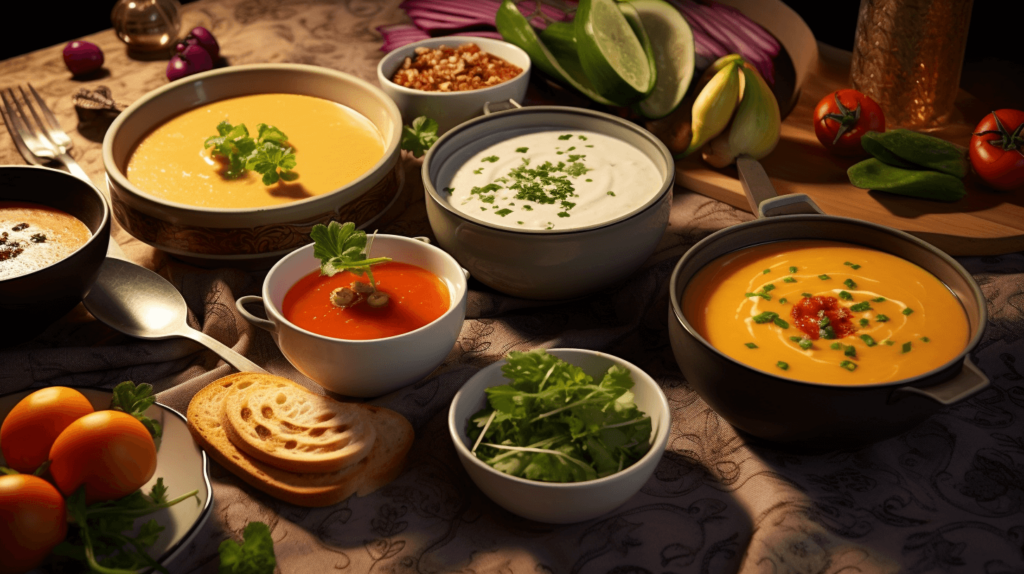Soups have long been a staple in many cultures around the world. They are comforting, nourishing, and versatile. However, they often get overlooked in the culinary world, overshadowed by more complex dishes. In this article, we will explore why soups deserve more attention and how to take them to the next level.
One of the reasons soups are often overlooked is because they are seen as simple and basic. However, this simplicity is what makes them so versatile. Soups can be made with a wide variety of ingredients, from vegetables and meats to legumes and grains. They can be light and refreshing or hearty and filling. They can be served as a starter or as a main course. The possibilities are endless.
In addition to their versatility, soups also offer numerous health benefits. They are an excellent way to incorporate more vegetables into your diet, providing essential vitamins and minerals. They can also be a great source of protein when made with beans or lean meats. Furthermore, soups are hydrating and can help with digestion. By giving soups more attention, we can unlock their full potential and enjoy their many benefits.
The Secret to Flavorful Broth: Tips for Making Homemade Stock
One of the keys to a delicious soup is using homemade stock. While store-bought stock can be convenient, it often lacks depth of flavor. Making your own stock is not as difficult as it may seem and can greatly enhance the taste of your soups.
To make flavorful stock, start by using bones or vegetable scraps. Bones from roasted meats or leftover chicken carcasses can add richness and depth to your stock. If you prefer a vegetarian option, save vegetable scraps like onion peels, carrot tops, and celery leaves to make a flavorful vegetable stock.
In addition to bones or vegetables, aromatics like onions, garlic, and herbs can be added to enhance the flavor of your stock. Simmer the ingredients in water for several hours, allowing the flavors to meld together. Strain the stock and discard the solids. You can then use the homemade stock as a base for your soups, adding even more depth and complexity to the final dish.
Elevating Basic Soups: Simple Additions for Extra Flavor and Texture
While a basic soup can be delicious on its own, adding simple additions can take it to the next level. One way to enhance the flavor of your soup is by adding herbs and spices. Fresh herbs like basil, cilantro, or parsley can add brightness and freshness to your soup. Spices like cumin, paprika, or turmeric can add depth and complexity.
Another important aspect of a great soup is texture. Adding crunchy elements like croutons, nuts, or seeds can provide contrast and make each bite more interesting. Croutons can be made by toasting cubes of bread in the oven until crispy. Nuts and seeds can be toasted in a dry pan until fragrant and then sprinkled on top of the soup before serving.
By incorporating these simple additions, you can transform a basic soup into a flavorful and satisfying meal.
Improving Soup Recipes: Substitutions and Modifications for Healthier and Tastier Soups
Soup recipes can often be modified to make them healthier without sacrificing flavor. One way to do this is by using low-sodium broth or stock. Many store-bought broths are high in sodium, which can contribute to high blood pressure and other health issues. By using low-sodium options or making your own stock, you can control the amount of salt in your soup.
Another way to make soups healthier is by reducing the amount of cream or butter used. While these ingredients can add richness and flavor, they can also contribute to a high calorie and fat content. Instead, try using pureed vegetables like cauliflower or butternut squash to thicken your soup. This will add creaminess without the added calories and fat.
Additionally, you can substitute ingredients to add more flavor and nutrition to your soups. For example, instead of using regular pasta, try using whole wheat or gluten-free options. Instead of using white rice, try using quinoa or brown rice. These substitutions can add more fiber and nutrients to your soup, making it a more balanced and nutritious meal.
The Importance of Seasoning: How to Balance Flavors and Spice Up Your Soups
Seasoning is a crucial step in making a delicious soup. It is important to balance flavors and ensure that the soup is well-seasoned. One way to do this is by tasting as you go. Start with a small amount of seasoning and gradually add more until the flavors are balanced.
In addition to salt and pepper, there are many other ways to add flavor to your soups. One option is to use acid, such as lemon juice or vinegar. Acid can brighten the flavors of a soup and add a tangy element. Another option is to use spices and herbs. Experiment with different combinations to find what works best for your taste preferences.
If you like spicy food, adding chili flakes, hot sauce, or fresh ginger can give your soup a kick. These ingredients can add depth and complexity to the flavors, making each spoonful more exciting.
Using Fresh Herbs and Spices: Tips for Incorporating Aromatics into Your Soups

Fresh herbs and spices are essential for adding depth and complexity to soups. They can elevate the flavors and make each bite more interesting. When using fresh herbs, it is important to add them towards the end of the cooking process to preserve their freshness and aroma.
Some common herbs used in soups include basil, thyme, rosemary, and parsley. These herbs can be added to the soup while it is simmering or sprinkled on top as a garnish. Experiment with different combinations to find what works best for your taste preferences.
In addition to herbs, aromatics like garlic, onion, and ginger can add depth and complexity to soups. These ingredients can be sautéed in oil or butter before adding the other ingredients. This will help release their flavors and enhance the overall taste of the soup.
Creamy Soups: How to Achieve the Perfect Texture and Consistency
Creamy soups can be a challenge to make, as achieving the perfect texture and consistency can be tricky. However, there are several tips and techniques that can help you achieve a velvety smooth soup without using cream.
One option is to use pureed vegetables or beans to thicken the soup. This will add creaminess without the added calories and fat. Simply blend cooked vegetables or beans until smooth and then add them to the soup. This will give the soup a rich and creamy texture.
Another option is to use a blender or immersion blender to puree the soup. This will break down any chunks and create a smooth consistency. Be sure to blend in small batches and be cautious of hot liquids, as they can splatter.
If you prefer a slightly chunky texture, you can use a potato masher or fork to mash some of the ingredients in the soup. This will create a thicker consistency while still maintaining some texture.
The Art of Garnishing: Simple Techniques for Making Your Soups Look and Taste Amazing
Garnishing is an important step in making your soups look and taste amazing. It adds visual appeal and can enhance the overall flavor of the dish. There are many simple techniques that can take your soups to the next level.
One option is to garnish with fresh herbs. Sprinkle chopped herbs like parsley, cilantro, or chives on top of the soup before serving. This will add freshness and brightness to the dish.
Another option is to add a dollop of yogurt or sour cream to the soup. This will add creaminess and richness. You can also swirl the yogurt or sour cream into the soup for a decorative effect.
Croutons are another popular garnish for soups. They add crunch and texture to each bite. You can make your own croutons by toasting cubes of bread in the oven until crispy.
Grated cheese is another simple yet delicious garnish for soups. Sprinkle grated cheese like Parmesan or cheddar on top of the soup before serving. The heat from the soup will melt the cheese, creating a gooey and flavorful topping.
Soups from Around the World: Exploring Different Cuisines and Ingredients
One of the great things about soups is their diversity. They vary greatly from culture to culture, offering a wide range of flavors and ingredients. Exploring different cuisines and ingredients can expand your culinary horizons and introduce you to new flavors and techniques.
For example, Italian cuisine is known for its hearty and flavorful soups like minestrone and ribollita. These soups are often made with a variety of vegetables, beans, and pasta or bread.
Asian cuisine offers a wide variety of soups, from light and refreshing options like miso soup to rich and spicy options like tom yum soup. These soups often feature ingredients like tofu, mushrooms, seafood, and exotic spices.
Mexican cuisine is famous for its comforting and flavorful soups like tortilla soup and pozole. These soups often feature ingredients like corn, beans, tomatoes, and chili peppers.
By exploring different cuisines and ingredients, you can expand your culinary repertoire and discover new flavors that will take your soups to the next level.
Soup Cooking Guide and Final Thoughts on Taking Your Soups to the Next Level
In conclusion, soups deserve more attention in the culinary world. They are versatile, comforting, and offer numerous health benefits. By following the tips and techniques discussed in this article, you can take your soups to the next level and create delicious and satisfying meals.
To summarize, start by making homemade stock for a flavorful base. Elevate basic soups by adding simple additions like herbs, spices, and crunchy toppings. Modify soup recipes to make them healthier and tastier by using low-sodium broth and reducing the amount of cream. Season your soups well and experiment with different flavors and spices. Use fresh herbs and aromatics to add depth and complexity. Achieve the perfect texture and consistency in creamy soups by using pureed vegetables or beans. Garnish your soups with fresh herbs, yogurt, croutons, or grated cheese to make them look and taste amazing. Finally, explore different cuisines and ingredients to expand your culinary horizons.
By following these tips and techniques, you can become a master of soup-making and create delicious meals that will warm your soul. So grab a pot, gather your ingredients, and start experimenting with different flavors and techniques. Your taste buds will thank you.
If you’re looking to elevate your soup game, you might also be interested in trying out this delicious Palmnut Soup recipe. Made with rich and creamy palmnut pulp, this West African dish is packed with flavor and will take your taste buds on a culinary adventure. Check out the recipe here and discover a new way to enjoy soups!





